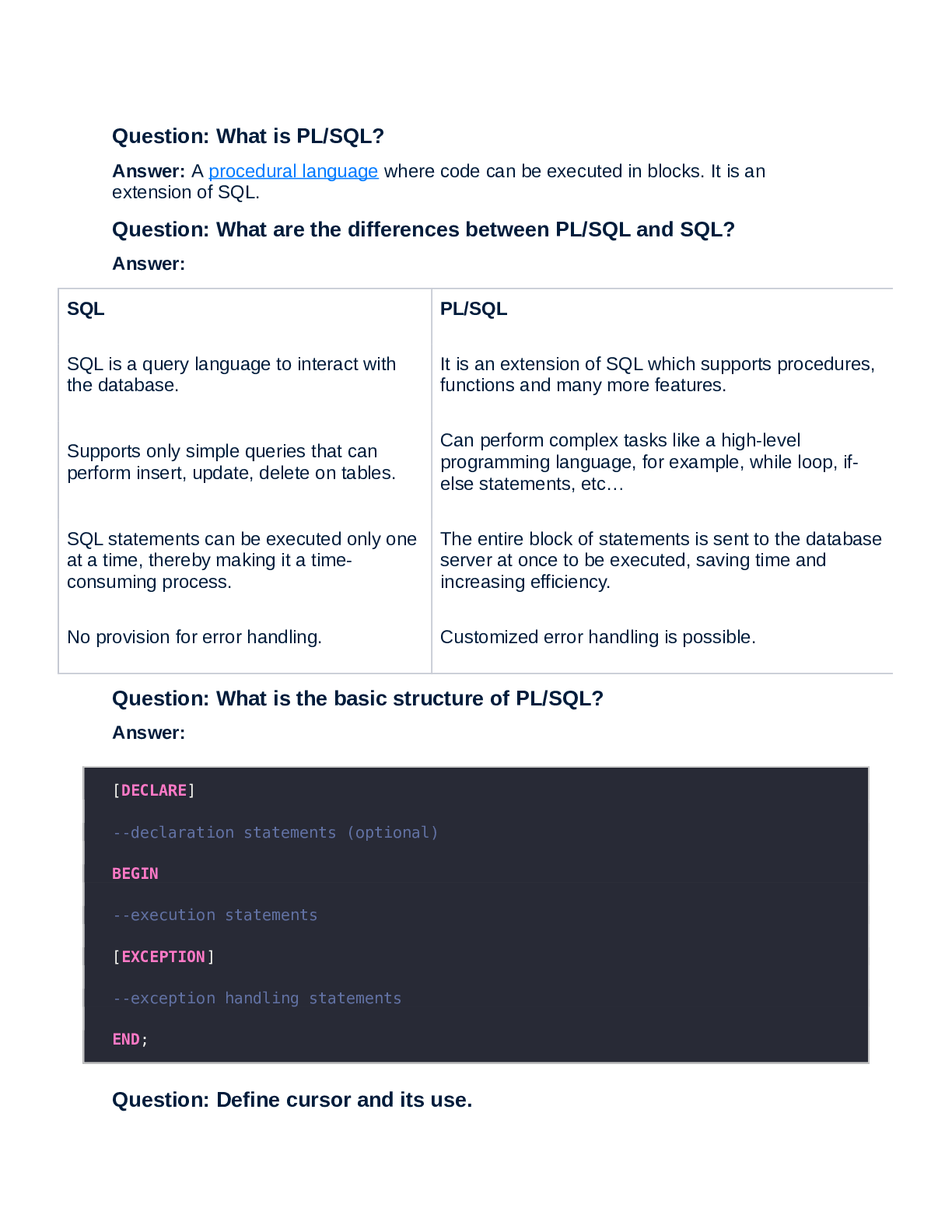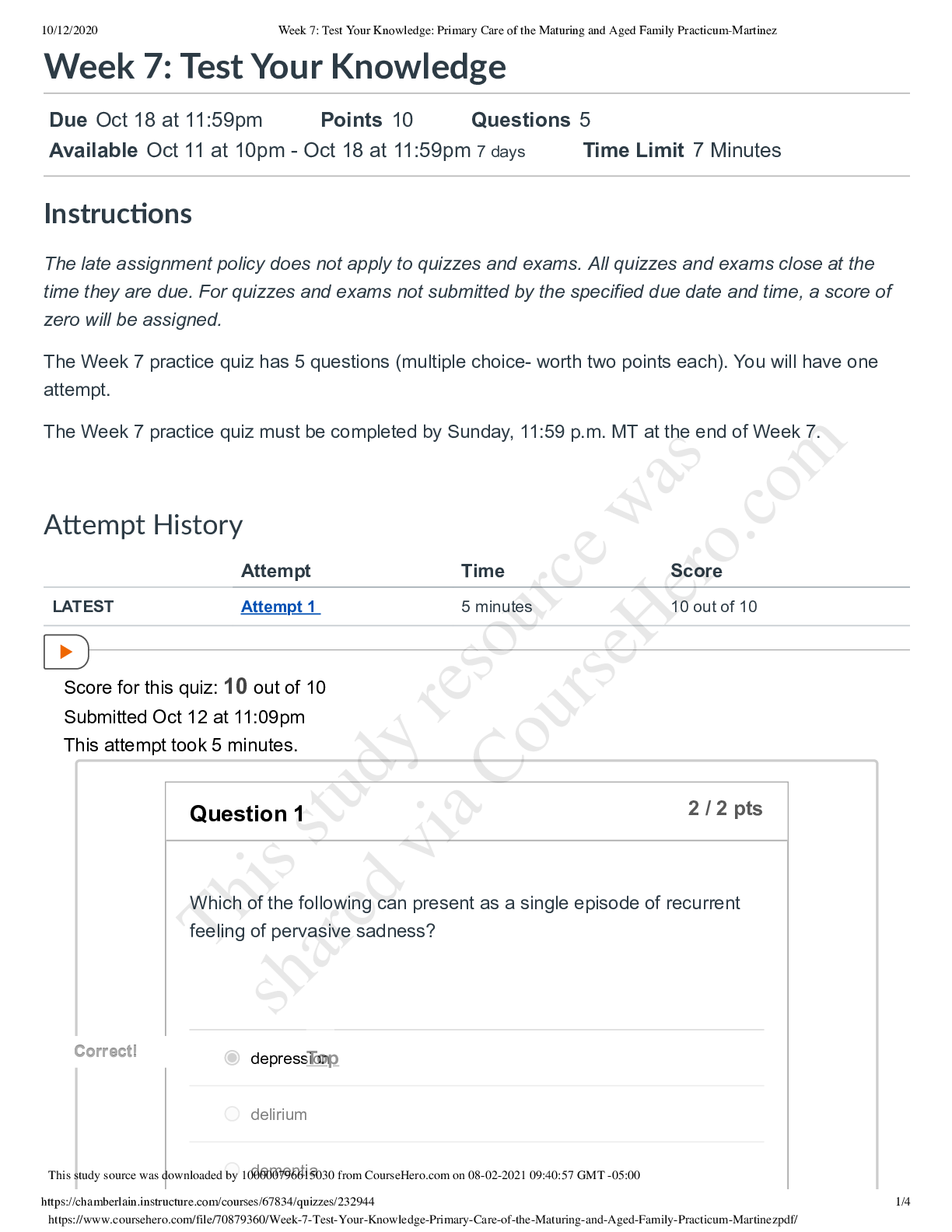*NURSING > QUESTIONS & ANSWERS > PL/SQL? Questions and answers, Graded A+, 2022 update (All)
PL/SQL? Questions and answers, Graded A+, 2022 update
Document Content and Description Below
Question: What is PL/SQL? Answer: A procedural language where code can be executed in blocks. It is an extension of SQL. Question: What are the differences between PL/SQL and SQL? Answer: SQL PL/... SQL SQL is a query language to interact with the database. It is an extension of SQL which supports procedures, functions and many more features. Supports only simple queries that can perform insert, update, delete on tables. Can perform complex tasks like a high-level programming language, for example, while loop, ifelse statements, etc… SQL statements can be executed only one at a time, thereby making it a timeconsuming process. The entire block of statements is sent to the database server at once to be executed, saving time and increasing efficiency. No provision for error handling. Customized error handling is possible. Question: What is the basic structure of PL/SQL? Answer: [DECLARE] --declaration statements (optional) BEGIN --execution statements [EXCEPTION] --exception handling statements END; Question: Define cursor and its use.Answer: A cursor is a pointer to a memory area assigned by Oracle to process SQL statements. The cursor is used to hold records returned by the SQL query. There are 2 types of cursors – implicit and explicit. Question: Why do we use database triggers? Give the syntax of a trigger. Answer: The trigger is a stored procedure that is automatically invoked when an event happens. The event could be: insert, update, delete, etc… Syntax – create trigger [trigger_name] [before | after] on [table_name] [for each row] [trigger_body] Question: How do you compile PL/SQL code? Answer: Firstly, the syntax check is performed. When the developer corrects any syntax errors, Oracle binds all the variables holding data with a storage address. Finally, the p-code generation process takes place. Question: Explain exception handling in PL/SQL. Answer: PL/SQL offers customized exception handling. When an error occurs, an error handling code is included in the program itself. There are 3 types of exceptions – Pre-defined exceptions – common errors that are already defined. Example – NO_DATA_FOUND Undefined exceptions – the errors that do not have predefined names. User-defined exceptions – handled by the code written by the user. Question: Tell about a few data types in PL/SQL. Answer: There are many data types – Scalar types – primitive data types like CHAR, DATE, LONG, VARCHAR2 etc… Composite – these are made up of other data types and can be easily updated. Example, RECORD, TABLE etc… Reference data types like CURSOR Large object types – BLOB, CLOB etc…Question: What is the difference between %TYPE and %ROWTYPE? Give an example. Answer: %TYPE %ROWTYPE The attribute that declares a variable of the same data type as of a table column. The attribute that declares a variable of type RECORD having the same structure as a table row. The row is the RECORD that contains fields having the same data types and names as the columns of a table or view. Example – DECLARE studentId students.student_id%TYPE; Example – DECLARE stud_rec students.%ROWTYPE; Question: What constitutes a PL/SQL package? Answer: Packages are schema objects that place functions, procedures, variables, etc… in one place. Packages should have – Package specifications Package body Question: List some schema objects that are created using PL/SQL. Answer: Database links, triggers, stored procedures, functions and packages, views, synonyms, external procedure libraries, sequences, etc… Check here: Basic SQL Commands Checklist Question: What are the various predefined exceptions? Answer: Predefined exceptions are internally defined exceptions that occur during the execution of a program. For example, PL/SQL raises NO_DATA_FOUND when there are no rows returned upon a select operation, and if more than one row is returned using a select statement, TOO_MANY_ROWS error is generated. Some more examples: COLLECTION_IS_NULL: when a collection is null CURSOR_ALREADY_OPEN: When a cursor is already open LOGIN_DENIED: When login is incorrect or permission is not there For the complete list of predefined exceptions, check out Oracle docs. Question: What is the difference between syntax and runtime errors? Answer: Syntax error Runtime error These are compile-time errors found by the compiler. These are not detected by the compiler and cause the program to give an incorrect result. The code doesn't build and run until these issues are resolved. The code is compiled and run, and if an error occurs, the program stops halfway. Some examples are missing semicolons or brackets (;, {}), incorrect spelling of classes, keywords etc. Examples are null pointer exceptions, dividing a number by zero, array index out of bounds, etc. int x = 9 String name = null; In the first line, a semicolon is missing which the compiler will catch String name = null; if(name.equals(“hackr.io”)){….} Since name is null, the exception will be caught during runtime when the code is executed Question: What are the various packages available for PL-SQL Developers? Answer: The several packages available for PL/SQL developers are: DBMS_ALERT alert an application using triggers when particular database values change. The alerts are transaction-based and asynchronous. DBMS_OUTPUT display output from PL/SQL blocks, packages, subprograms and triggers. Mostly used for displaying PL/SQL debugging information. DBMS_PIPE different sessions communicate over named pipes using this package. The procedures PACK_MESSAGE and SEND_MESSAGE pack a message into a pipe, then send it to another session. HTF and HTP allow PL/SQL programs to generate HTML tags.UTL_FILE lets PL/SQL programs read and write OS text files. UTL_HTTP allows your PL/SQL programs to make hypertext transfer protocol (HTTP) callouts. The package has two entry points, each of which accepts a URL (uniform resource locator) string, contacts the specified site, and returns the requested data, which is usually in HTML format. UTL_SMTP allows PL/SQL programs to send emails over SMTP. Question: Explain Character Functions? Answer: Character functions are functions that manipulate character data. These are more popularly called as string functions. Example: LEFT Returns the mentioned number of characters from left of a string. LEFT(value, NoOfChars). Example LEFT('Hackr', 4) will give Hack. RIGHT return specified number of characters from right. RIGHT(value, NoOfChars). Example RIGHT('banker', 2) will return er. SUBSTRING selects data from any part of the string. SUBSTRING(value, StartPosition, NoOfChars). Example SUBSTRING('hackr.io',0,4) will return hackr. LTRIM trims white spaces from the left. Example LTRIM(' hackr.io') will return hackr.io. RTRIM trims white spaces from the right. Example RTRIM('hackr.io ') will return hackr.io. UPPER converts all the characters to uppercase. Example UPPER('hackr.io') returns HACKR.IO. LOWER converts all the characters to lowercase. LOWER('HACKR.IO') returnsExample hackr.io. Question: What is the use of SYSDATE and USER keywords? Explain with examples. Answer: SYSDATE: returns the current date and time on the local database server. The syntax is SYSDATE. If we have to extract part of the date, then we use the TO_CHAR function. Examples: SELECT SYSDATE FROM dual; select customer_id, TO_CHAR(SYSDATE, 'yyyy/mm/dd') from customer where customer_id < 200; USER: USER returns the user_id of the current session. Example: select USER from dual; Question: What is the difference between SGA and PGA? Answer: SGA PGA System Global Area Program Global Area Contains data and control information for one Oracle database instance Contains data and control information exclusively for a single Oracle process Shared memory region for components Non-shared memory region example: cached data blocks and SQL areas Example: session memory, SQL work area Question: Explain the uses of Merge with Syntax in PL-SQL. Answer: Merge reduces the number of table scans and performs parallel operations if required. MERGE inserts or updates data conditionally from one table to another. For example [Show More]
Last updated: 2 years ago
Preview 1 out of 46 pages

Buy this document to get the full access instantly
Instant Download Access after purchase
Buy NowInstant download
We Accept:

Reviews( 0 )
$8.00
Can't find what you want? Try our AI powered Search
Document information
Connected school, study & course
About the document
Uploaded On
Aug 24, 2022
Number of pages
46
Written in
Seller

Reviews Received
Additional information
This document has been written for:
Uploaded
Aug 24, 2022
Downloads
0
Views
154












.png)




.png)






